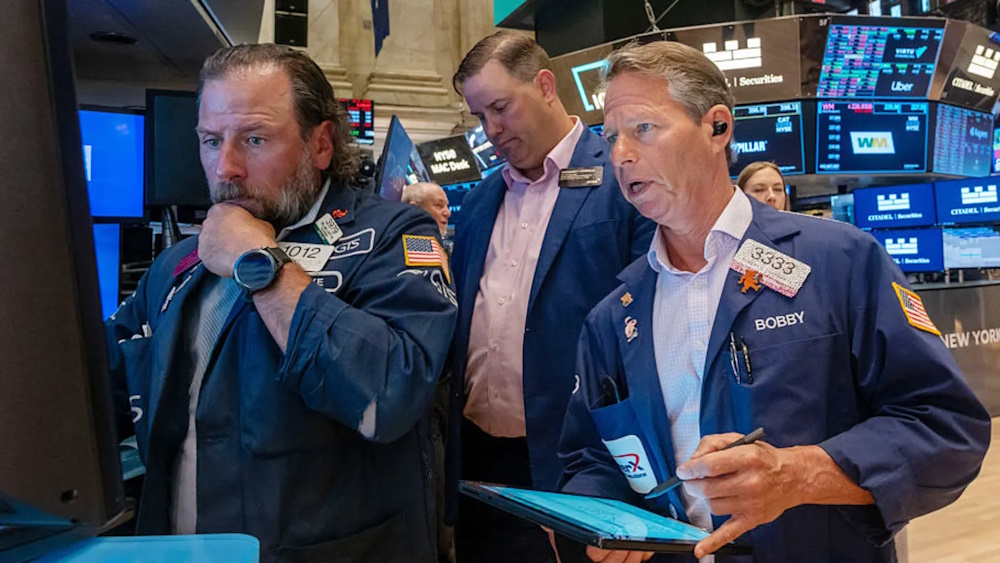
US equities experienced a significant decline on Friday following President Donald Trump’s warning of potential tariff increases on imports from China, which has rekindled concerns about a trade war that previously unsettled global markets earlier this year. The Dow experienced a decline of 879 points, representing a decrease of 1.9%. The broader S&P 500 experienced a decline of 2.71%, while the tech-heavy Nasdaq Composite fell by 3.56%. The S&P 500 and Nasdaq experienced their most significant decline since April, driven by a downturn in technology stocks that pulled the market downward. The Dow experienced its most significant decline since May. The S&P 500 experienced a decline of 2.71%, resulting in a loss of approximately $1.56 trillion in market capitalization within a single trading session. Trump stated that he is contemplating a “massive increase” in tariffs on imports from China, asserting, “There is no way that China should be allowed to hold the World ‘captive’” regarding rare earth exports.
The most recent threat arises from allegations that China is implementing export controls on rare earths and is delaying prior agreements intended to facilitate access for US companies. Consequently, Trump indicated that he no longer perceives a necessity to engage in discussions with President Xi Jinping later this month during the Asia-Pacific Economic Cooperation summit in South Korea. US equities had been oscillating around all-time peaks. In recent months, Wall Street has sought to overlook apprehensions regarding tariffs, directing its attention instead to corporate earnings that have surpassed expectations. The president’s post had a significant impact on markets, resulting in a 32% surge in Wall Street’s fear gauge, the CBOE Volatility Index, reaching its highest level since June. “That was evidently not a sentiment traders were inclined to embrace!” According to Steve Sosnick in a recent note. “We had grown used to markets that were relatively calm with a tendency to rise, so it was quite surprising to witness stocks in a rapid decline.” Stocks related to AI and semiconductors, which are particularly responsive to shifts in US-China trade dynamics, experienced a decline. Nvidia and Advanced Micro Devices experienced declines of 4.95% and 7.78%, respectively. “The escalation of tensions with China is the significant narrative,” stated Ross Mayfield. “It certainly surprised the markets.” In recent weeks, concerns have emerged regarding the valuations of AI and tech stocks, rendering them more susceptible to unforeseen developments.
“When you have a shock like today with President Trump, they are going to get hit the most because they’re the most at risk to the economic outlook worsening or corporate earnings retreating due to a potential slowdown,” stated José Torres. Meanwhile, US-based rare earth mining and processing companies experienced a notable increase. USA Rare Earth experienced an increase of 4.96%, while MP Materials saw a rise of 8.37%. US Treasuries experienced a rally as investors flocked to safer assets in response to market volatility and apprehensions that a renewed trade war might adversely affect economic growth. Yields on 10-year and 30-year Treasuries declined as investors increased their bond purchases. Gold and silver, recognized as safe havens during periods of turmoil, experienced increases of 1.5% and 1.2%, respectively. “Trump is igniting risk-off sentiments in markets following his announcement regarding the possibility of substantial tariff increases on China,” Torres stated. “Investors are seeking safe haven holdings due to a significant rise in levies that may impact earnings and the economic outlook moving forward.” US oil prices experienced a decline of 4.2%, while Brent crude fell by 3.8%, reaching their lowest levels since May.
Oil prices experienced a decline earlier, influenced in part by the ceasefire developments between Israel and Hamas. Robert Yawger, indicated that the escalation in tensions between Trump and Xi has heightened fears of a “demand destruction event,” in which a trade war adversely impacts economic growth and oil demand. “It’s a mini mirror image of what happened in April,” Yawger noted, alluding to the decline in oil prices during the spring as investors adjusted their forecasts regarding a potential recession. Fear and Greed index has transitioned from a state of “neutral” to “fear” for the first time since May. The Dow, S&P 500, and Nasdaq all recorded negative performance for the month. “The sell-off has the potential to evolve into a larger correction, especially if the US-China trade truce is over,” stated Michael O’Rourke. “Throughout the summer, the dominance of greed over fear in the US equity market has been pronounced, and the prevailing complacency positions investors at risk.”

